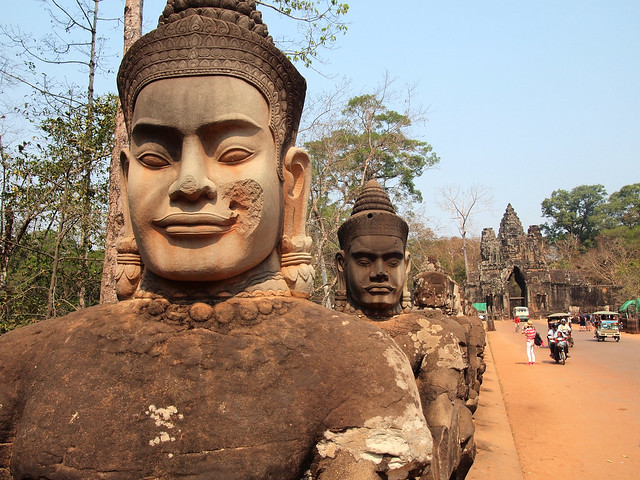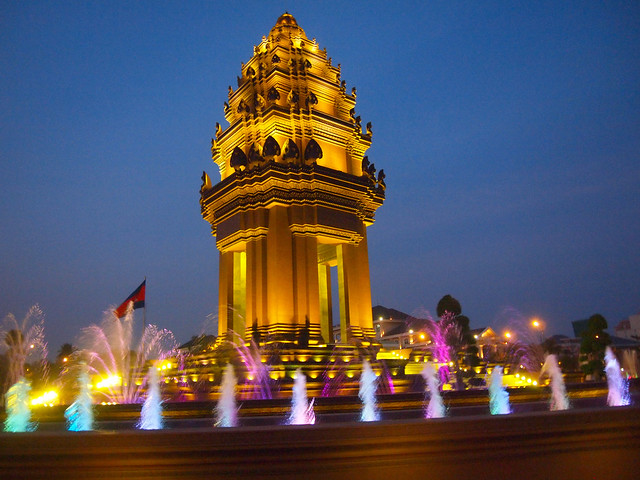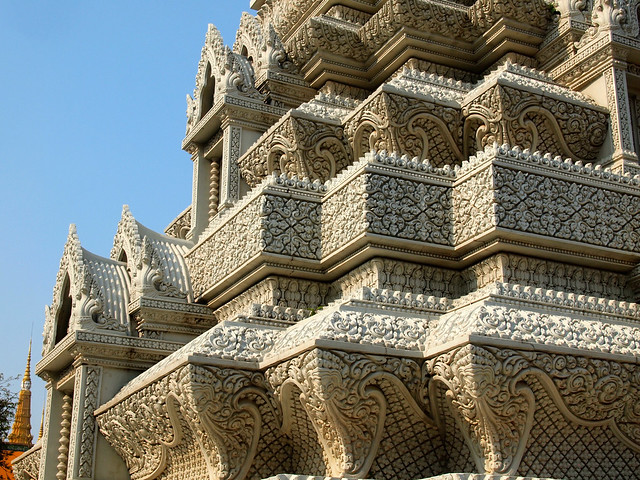Thoughts on Cambodia

When I came home from Southeast Asia, everyone wanted to know what I thought about it. And it was mostly easy to tell them: Hong Kong was crowded and very tall; Vietnam was beautiful in every sense of the word: Thailand was tropical and relaxing.
But then I would get to Cambodia, and describing my experience there wasn't so easy.

It's not that I disliked Cambodia; far from it. I loved exploring the Angkor temples, had fun riding the bamboo train, and was even amused by watching people eating spiders. But I was also deeply saddened by visiting the Killing Fields, and disturbed to see how much the country struggles with corruption and poverty.
Cambodia is poorer, less developed, and in general in more trouble than almost any other nation in Southeast Asia. And, because of this, I was really conflicted about my time there.
“It will break your heart”
I've been reading up a bit on Cambodia and its history recently, in hopes of being able to better wrap my head around it. Throughout my reading, I've come across a quote from a former U.S. Ambassador to Cambodia more than once. The quote goes:
Be careful because Cambodia is the most dangerous country you will ever visit. You will fall in love with it and eventually it will break your heart.
And he was absolutely right.
Seeing stark economic disparity broke my heart. The Royal Palace in Phnom Penh, for example, is immaculately well manicured, with buildings covered in gold and filled with valuables. But then you walk out into the city, where there is trash all over the streets and people living in extreme poverty.
According to the United Nations' Human Development Index, Cambodia only ranks #146 out of 195, with 46% of people living on less than $3 per day.

Driving through garbage-riddled villages on unpaved, pothole-filled roads broke my heart. Neighboring countries like Vietnam and Thailand are also increasing in popularity among tourists, but development there seems to be keeping apace, with decent roads and modern amenities found all over.
Cambodia, meanwhile, is lagging far behind, with a struggling economy, issues with hunger, and a lack of education.

Learning about the corruption in Cambodia broke my heart. I paid $20 to enter the country, and another $40 to get a 3-day pass to the Angkor temples. That amount right there is more than most Cambodians make in a month — no small sum.
So where does that money go? Well, the border fee no doubt goes right into someone's pocket (and it's not uncommon for border guards to intimidate even MORE money out of tourists). According to the Corruption Perceptions Index from 2017, Cambodia ranks in the top 20 most corrupt nations in the world, and it's painfully evident if you look for it.

And there are plenty more heartbreaking examples: kids begging on the streets (many of whom do this “professionally” instead of going to school); touts pestering tourists inside religious sites; locals — including tour guides — throwing rubbish on the ground.
Add to this rampant exploitation of the poor and the weak (Cambodia has one of the worst reputations in the world when it comes to child sex trafficking) and it's beyond heartbreaking.
Cambodia has a lot to offer, but if you open up your eyes to the reality playing out in this country, I'll bet it would break your heart, too.
A Cambodia history lesson
To understand part of Cambodia's current plight, you really must visit sites like the Killing Fields and talk to the people who survived the Khmer Rouge era. In the 1970s, the brutal Khmer Rouge regime ruled Cambodia with an iron fist, killing millions of educated people and sending the rest to collective farms and labor camps — where millions more died of starvation and disease.
The Khmer Rouge years — still remembered vividly by anyone in Cambodia over the age of 40 — took a severe toll on Cambodia and have undoubtedly affected every person living in the country today.
After the genocide in the '70s — which strapped many Cambodians with severe cases of post-truamatic stress disorder (PTSD) that studies have suggested is now being passed on to their children — the country was divided.
The Soviet-backed Vietnamese were running a puppet government from Phnom Penh, while the Chinese still supported the Khmer Rouge armies hiding out in the jungle. The U.S. was largely trying to stay out of the mess after the whole debacle in Vietnam (which also included bombing parts of southern Cambodia to bits, too). Meanwhile, the average Cambodian continued to suffer.
After the fall of the Soviet Union (and once the genocide could no longer be ignored), the United Nations actually stepped in and tried to run Cambodia from 1992-93 in attempts to make up for the decades the West spent ignoring what was going on there.
This was the first (and only) time the UN ever did anything like this. Afterwards, the country was supposed to become a prospering democracy.
But that didn't happen.

The UN didn't have the money, the troops, or the influence to really affect any real change in Cambodia. Yes, the organization pumped $3 billion into the country and WAS successful in setting up elections in which 90% of eligible voters participated.
But, after the election, things went right back to the way they had always been, with different political leaders vying for control as if the people had never spoken at all.
One of the at-odds leaders was Hun Sen, the communist leader who had been appointed to run the country when Vietnam liberated it from the Khmer Rouge. After the UN elections, Hun Sen helped “run” Cambodia in a semi-coalition government with the royalist party until 1997, when his army led a small coup and took control of the country back.
Hun Sen has ruled the pseudo-democracy ever since, but with frequent reports of rigged elections.
Some argue that the cycle of corruption and human rights failures is just intrinsic to Cambodia as a nation. Dating back to the ancient Khmer Empire (800s-1400s AD), officials and kings were lining their pockets and getting rich while the poor remained poor and slave labor was the way to get things done.
One author suggests that Cambodian culture on the whole lacks a drive to succeed, and that this, coupled with the Theravada Buddhism belief that people should be pleased with the lives they have and not aspire for more, has molded Cambodians into a passive people; victims of their own shortcomings.
I'm not so sure I agree, however. Subject a people to horror and repression and poverty long enough, and of course they will accept it as the status quo. What would happen, though, I wonder, if Cambodians were more empowered, both from within their country and from without?
Recent protests by garment factory workers demanding better pay and working conditions suggest that not all Cambodians are willing to accept the lot in life they've been (perhaps unfairly) dealt. And many Cambodians I spoke with gladly shared their opinions with me about the current corrupt government and how they (along with many others) would like to get rid of it. Post-election protests in 2013 support this opinion and prove that not all Cambodians are happy to passively sit by and observe any longer.
Unfortunately, however, as long as the Prime Minister wields absolute power, it's unlikely that anything will change.
So what does this mean for tourism in Cambodia?
As I mentioned above, Southeast Asia is emerging as a popular tourist destination. Nearby countries like Thailand and Vietnam are enjoying the economic boost that tourism provides, and Cambodia, being placed in between the two, is also seeing an influx of visitors.
In fact, tourism is Cambodia's fastest-growing industry.

But in Cambodia, development is outpacing infrastructure. The country is so desperate to catch up that people are ignoring how completely ill equipped Cambodia is to deal with such an increase in tourists.
The people have not been educated enough about tourism development or sustainability. Things like waste management, food safety, and historic preservation are largely ignored, even in areas that are seeing lots of tourists.
For example, more and more people (millions of them) visit the Angkor temples each year, but the infrastructure in Siem Reap — not to mention the preservation of the temples themselves — remains quite basic.
I enjoyed my time in Siem Reap, but it's actually sad to imagine what the city and temples will look like 10 or 20 years from now due to over-visitation and unsustainable development.

And then there's the crime. In places like Phnom Penh, you are advised to always hold tight to your bag, and NEVER have things like iPhones or iPads out in your hands when you are walking around or riding in a tuk-tuk. Even the drivers will warn you about this. Tourists, unfortunately, are becoming easy targets here.
I will not tell you to avoid Cambodia because of any of this, though. There's a reason so many people fall in love with it, after all. But this should all be food for thought.
What can we do?
Ask Cambodians how their nation can be improved, and they will say that Western powers need to step in, get rid of Hun Sen's corrupt government, and help them develop the country and economy.
Easier said than done, of course, especially if we look at recent history. Historically speaking, Cambodia has been quite averse to help that doesn’t also line the pockets of officials. The UN couldn’t affect any lasting change, and the thousands of NGOs operating in the country have not yet helped the people get rid of a government they no longer (and really never did) support.
Nations from around the world have been pumping billions of aid dollars into Cambodia for decades, and yet people outside of the cities live and work exactly as they would have done 300 years ago.

Some may say that volunteering (or, God forbid, starting up yet another non-profit) is the way to truly help in Cambodia. But I would be very reluctant to suggest this route.
Many volunteering schemes in Cambodia are scams — many orphanages, for example, exist purely as tourist attractions, and parents actually SEND their children there to make money. Pumping money into Cambodia, in some cases, could actually do more harm than good.
In my opinion, the only way to help Cambodia as a tourist is to be conscious of your decisions while there, and to be aware of how your presence is affecting the country.
Be a “good” tourist” in Cambodia
Small gestures — like going to a local restaurant that helps street kids or shopping somewhere that employs people with disabilities — can go a long way. Here are some things to keep in mind:
BEGGARS
Whatever you do, don't give money to child beggars you see on the street. These kids are purposefully kept out of school to try to sell you postcards and bracelets. They may be cute. They may be charming. But I promise that none of that money is actually going to help them go to school. They are employed (or enslaved) by someone, and they will see none of your money at the end of the day.
It's often harder to ignore beggars who are missing limbs — many of them were innocent victims of land mines that the U.S. left behind during its war with Vietnam, or of the acts of the Khmer Rouge. However, many of them ARE offered help and even artificial limbs by local NGOs. But many of them realize that they can make more money by begging on the street than working a regular job.
Whether you give them anything is of course up to you, but just keep in mind that people with any sort of disability — be it one they were born with, or one they have acquired — should be treated the same as everyone else.
Instead of giving people money, offer to buy them a meal. It's the easiest way to sort out who is truly in need from those just trying to play to your sympathies.
And, if you really want to support disadvantaged kids, do some research before you go to Cambodia about local restaurants and programs that train street kids as cooks and wait staff and teach them English and business skills. Some places I personally visited included Friends in Phnom Penh, Jaan Bai in Battambang, and Genevieve's in Siem Reap.
LITTERING
Set a good example. DO NOT throw rubbish on the ground, even if you see the locals doing it.
Driving through the countryside in Cambodia especially is depressing. The poverty is difficult to see, as is all the trash and pollution. Much of it can be blamed on a simple lack of education — people who once wrapped up their food in banana leaves and then discarded them in the river haven't been properly taught that plastic doesn't work the same way.
Set a good example by at least disposing of your garbage properly.
HAGGLING
Pick your battles when it comes to haggling. I got quite angry one day in Siem Reap when I saw someone arguing over 50 cents with a tuk-tuk driver. Unless you legitimately feel that you are being ripped off, don't do this. These guys are not begging on the street corner or trying to exploit a disability or misfortune — they are trying to make a living the best way they can.
Does it really make a huge difference to YOU whether you pay $1.00 or $1.50 for a ride into the city? You can probably part with the money.
Too many times travelers in this part of the world lose sight of reality and become obsessed with spending as little money as possible. Sure, saving money feels good. Sure, haggling is expected in Asia. And sure, the locals will always quote a foreign tourist a higher rate. But that doesn't mean that it's worth getting stingy over 50 cents.
Most of all, just go to Cambodia with open eyes. Talk to the people. Try to understand what has happened there.
And then come home and tell everybody you know. Because, sad as it is, I really do believe that spreading the word about the plight of Cambodia is the only way to truly help it.
Have you been to Cambodia? What was your experience like?

Amanda Williams is the award-winning blogger behind A Dangerous Business Travel Blog. She has traveled to more than 60 countries on 6 continents from her home base in Ohio, specializing in experiential and thoughtful travel through the US, Europe, and rest of the world. Amanda only shares tips based on her personal experiences and places she's actually traveled!

















Your article on Cambodia is a poignant blend of beauty and harsh reality. It’s a stark reminder of our responsibilities as tourists and the impact we can have. Your call to action is powerful – we can all contribute to change by raising awareness. This piece is deeply impactful, and will surely resonate with many. Thanks for sharing your experiences.
I enjoyed reading your article. Having travelled and worked in this amazing country and being familiar with its history too, I think it is a very objective way to present this country. I think it will be useful to any person preparing for a trip there. I also found your article interesting as, if we had the same kind of impressions about Cambodia, our opinions vary about our experiences in Thailand and Vietnam. I saw the beauty of Vietnam for sure and the tropical charm of Thailand (and I am the first one to jump on a plane to enjoy the food there and a good massage) but I also witnessed terrible poverty, child and animal abuse, pollution and child prostitution. I am not saying the countries are the same but I personally found less contrasts between them than you did. It gave me an opportunity to reflect. Thanks.
Thank you for trying to understand and learn about Cambodia, as Khmer people, I am touching by your posted.
I’m glad there are people from other countries love my country.
My mom always told me and brother about what she’s gone through. It’s break my hearts every time I thinks about it.
We have visited Cambodia as well and left it with the feeling you describe. Good that you share these thoughts with the world. Cambodia is a beautiful country, with lovely proud people. But there is a sad history and still very much corruption.